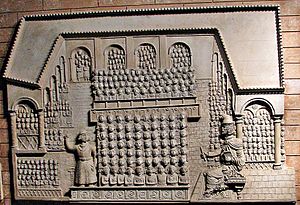Rav Ashi
| Rabbinical eras |
|---|

Rav Ashi (
The original pronunciation of his name may have been Ashei, as suggested by the rhyming of his name with "Mosheh" in Maimonides' writings,[1] and a possible rhyme with the word mikdashei (Psalms 73:17) in the Talmud itself.[2]
Biography
According to a tradition preserved in the academies, Rav Ashi was born in the same year that
Ashi was rich and influential, owning many properties and forests.[6] The Talmud gives him as an example of "Torah and greatness combined in one place", that is to say, he possessed both scholarly accomplishment and political authority,[7] and he had authority even over the exilarch Huna bar Nathan.[7]
Elevation of Sura
While still young, Rav Ashi became the head of the
Sura maintained the prominence conferred on it by Rav Ashi for several centuries, and only during the last two centuries of the
Compilation of the Gemara
His commanding personality, his scholarly standing, and wealth are sufficiently indicated by the saying, then current, that since the days of Rabbi
Together with his disciples and the scholars who gathered in Sura for the "
Beyond this, the Talmud itself contains not the slightest intimation of the activity which Ashi and his school exercised in this field for more than half a century. Even whether this editorial work was written down, and thus, whether the putting of the Babylonian Talmud into writing took place under Rav Ashi or not, cannot be answered from any statement in the Talmud. It is nevertheless probable that the fixation of the text of so comprehensive a literary work could not have been accomplished without the aid of writing.[11]
The work begun by Rav Ashi was continued in the two succeeding generations and completed by
Teachings
- A talmid chacham who is not as strong as iron is not a talmid chacham.[13]
- Whoever is arrogant is blemished.[14]
Tomb of Rav Ashi

According to traditional
See also
- Mar bar Rav Ashi, his son, the seventh generation Amora sage of Babylon
References
- ^ In Iggeret Teiman
- ^ a b Bava Metzia 86a
- ^ Kiddushin 72b
- ^ Beitzah 29b; however, according to Aharon Heimann (Toldot Tanaaim veAmoraim) this is a misprint.
- ^ Hullin 111a
- ^ Moed Kattan 12b; Nedarim 62b
- ^ a b c Gittin 59a; Sanhedrin 36a
- OCLC 923562173.
In all those years after R. Pappa, R. Ashi was gaon in Sura. He came to Mata Mehasya, tore down the Synagogue of Bei Rav, and rebuilt it (as we say in [Chapter] HaShutafin), making a number of fine improvements. He convened [in Mata Mehasya] festivals and fast days that [until then] had been the prerogative only of the exilarch and in Nehardea.
- Babylonian Talmud(Shabbat 11a; Baba Bathra 3b)
- ^ Berachot 17b
- ^ a b c d
 One or more of the preceding sentences incorporates text from a publication now in the public domain: Jastrow, Marcus; Bacher, Wilhelm (1901–1906). "Ashi". In Singer, Isidore; et al. (eds.). The Jewish Encyclopedia. New York: Funk & Wagnalls.
One or more of the preceding sentences incorporates text from a publication now in the public domain: Jastrow, Marcus; Bacher, Wilhelm (1901–1906). "Ashi". In Singer, Isidore; et al. (eds.). The Jewish Encyclopedia. New York: Funk & Wagnalls.
- ^ Bava Batra 157b
- ^ Taanit 4a
- ^ Megillah 29a
- ^ קבר הרב יחולק: חציו בישראל, חציו בלבנון
![]() This article incorporates text from a publication now in the public domain: Jastrow, Marcus; Bacher, Wilhelm (1901–1906). "Ashi". In Singer, Isidore; et al. (eds.). The Jewish Encyclopedia. New York: Funk & Wagnalls.
It has the following bibliography:
This article incorporates text from a publication now in the public domain: Jastrow, Marcus; Bacher, Wilhelm (1901–1906). "Ashi". In Singer, Isidore; et al. (eds.). The Jewish Encyclopedia. New York: Funk & Wagnalls.
It has the following bibliography:
- Letter of Sherira Gaon;
- Heilprin, Seder ha-Dorot;
- Zacuto, YuḦasin;
- Weiss, Dor, iii. 208 et seq.;
- W. Bacher, Agada der Babyl. Amoräer, p. 144.
